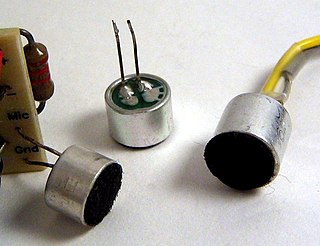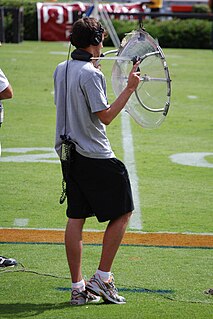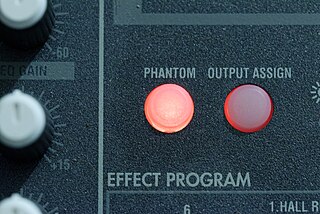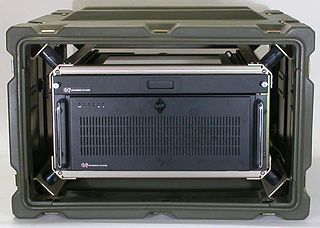 W
WA microphone, colloquially named mic or mike, is a device – a transducer – that converts sound into an electrical signal. Microphones are used in many applications such as telephones, hearing aids, public address systems for concert halls and public events, motion picture production, live and recorded audio engineering, sound recording, two-way radios, megaphones, radio and television broadcasting. They are also used in computers for recording voice, speech recognition, VoIP, and for non-acoustic purposes such as ultrasonic sensors or knock sensors.
 W
WNeumann U 47 is a large-diaphragm condenser microphone. It is one of the most famous studio microphones and was Neumann's first microphone after the Second World War. The original series, manufactured by Georg Neumann GmbH between 1949 and 1965, employed a tube design; early U 47s used the M 7 capsule, then replaced by the K 47 from 1958. Units produced before 1950 were distributed by Telefunken and bear the Telefunken logo.
 W
WAKG Acoustics is an acoustics engineering and manufacturing company. It was founded in 1947 by Dr. Rudolf Görike and Ernest Plass in Vienna, Austria. It is a part of Harman International Industries, a subsidiary of Samsung Electronics.
 W
WThe BBC-Marconi Type A is a ribbon microphone that was produced by the BBC and Marconi between 1934 and 1959. The microphone has been described as "iconic" and a symbol of the BBC.
 W
WBinaural recording is a method of recording sound that uses two microphones, arranged with the intent to create a 3-D stereo sound sensation for the listener of actually being in the room with the performers or instruments. This effect is often created using a technique known as "dummy head recording", wherein a mannequin head is outfitted with a microphone in each ear. Binaural recording is intended for replay using headphones and will not translate properly over stereo speakers. This idea of a three dimensional or "internal" form of sound has also translated into useful advancement of technology in many things such as stethoscopes creating "in-head" acoustics and IMAX movies being able to create a three dimensional acoustic experience.
 W
WBlumlein pair is the name for a stereo recording technique invented by Alan Blumlein for the creation of recordings that, upon replaying through headphones or loudspeakers, recreate the spatial characteristics of the recorded signal.
 W
WA boundary microphone is a small omnidirectional condenser mic capsule positioned near or flush with a boundary (surface). The arrangement provides a directional half-space pickup pattern while delivering a relatively phase-coherent output signal.
 W
WThe carbon microphone, also known as carbon button microphone, button microphone, or carbon transmitter, is a type of microphone, a transducer that converts sound to an electrical audio signal. It consists of two metal plates separated by granules of carbon. One plate is very thin and faces toward the speaking person, acting as a diaphragm. Sound waves striking the diaphragm cause it to vibrate, exerting a varying pressure on the granules, which in turn changes the electrical resistance between the plates. Higher pressure lowers the resistance as the granules are pushed closer together. A steady direct current is passed between the plates through the granules. The varying resistance results in a modulation of the current, creating a varying electric current that reproduces the varying pressure of the sound wave. In telephony, this undulating current is directly passed through the telephone wires to the central office. In public address systems it is amplified by an audio amplifier. The frequency response of most carbon microphones, however, are limited to a narrow range, and the device produces significant electrical noise.
 W
WConference microphone is the microphone specially designed for the communication in the conference. Conference microphones can be divided into two kinds, the wired conference microphone, which is based on the cable to transmit its signal to perform the communication task; another one is the wireless conference microphone, which is based on Wi-Fi or IR technology to communicate among the microphones.
 W
WA contact microphone, also known as a piezo microphone, is a form of microphone that senses audio vibrations through contact with solid objects. Unlike normal air microphones, contact microphones are almost completely insensitive to air vibrations but transduce only structure-borne sound. Often used as acoustic leakage probes, they also enjoy wide usage by noise music artists experimenting with sound. Contact microphones can be used to amplify sound from acoustic musical instruments, to sense drum hits, for triggering electronic samples, and to record sound in challenging environments, such as underwater under high pressure.
 W
WA microphone, colloquially named mic or mike, is a device – a transducer – that converts sound into an electrical signal. Microphones are used in many applications such as telephones, hearing aids, public address systems for concert halls and public events, motion picture production, live and recorded audio engineering, sound recording, two-way radios, megaphones, radio and television broadcasting. They are also used in computers for recording voice, speech recognition, VoIP, and for non-acoustic purposes such as ultrasonic sensors or knock sensors.
 W
WAn electret microphone is a type of electrostatic capacitor-based microphone, which eliminates the need for a polarizing power supply by using a permanently charged material.
 W
WMicrosoft HoloLens 2 is a pair of mixed reality smartglasses developed and manufactured by Microsoft. It is the successor to the pioneering Microsoft HoloLens. On February 24, 2019 the HoloLens 2 enterprise edition debuted as the first variant of the device, followed by a developer edition that was announced on May 2, 2019. It was subsequently released in limited numbers on November 7, 2019.
 W
WA Jecklin disk is a sound-absorbing disk placed between two microphones to create an acoustic "shadow" from one microphone to the other. The resulting two signals can possibly produce a pleasing stereo effect. A matching pair of small-diaphragm omnidirectional microphones is generally used for this technique.
 W
WA lavalier microphone or lavalier is a small microphone used for television, theatre, and public speaking applications in order to allow for hands-free operation. They are most commonly provided with small clips for attaching to collars, ties, or other clothing. The cord may be hidden by clothes and either run to a radio frequency transmitter kept in a pocket or clipped to a belt, or routed directly to the mixer or a recording device.
 W
WA mic drop is the gesture of intentionally dropping one's microphone at the end of a performance or speech to signal triumph. Figuratively, it is an expression of triumph for a successful event and indicates a boastful attitude toward one's own performance.
 W
WA microphone stand is a free-standing mount for a microphone. It allows the microphone to be positioned in the studio, on stage or on location without requiring a person to hold it.
 W
WMicrophonics, microphony, or microphonism describes the phenomenon wherein certain components in electronic devices transform mechanical vibrations into an undesired electrical signal (noise). The term comes from analogy with a microphone, which is intentionally designed to convert vibrations to electrical signals.
 W
WMicrosoft HoloLens, known under development as Project Baraboo, are a pair of mixed reality smartglasses developed and manufactured by Microsoft. HoloLens was the first head-mounted display running the Windows Mixed Reality platform under the Windows 10 computer operating system. The tracking technology used in HoloLens can trace its lineage to Kinect, an add-on for Microsoft's Xbox game console that was introduced in 2010.
 W
WThe NOS stereo technique is a method of capturing stereo sound.
 W
WThe ORTF stereo microphone system, also known as Side-Other-Side, is a microphone technique used to record stereo sound.
 W
WOverhead microphones are those used in sound recording and live sound reproduction to pick up ambient sounds, transients and the overall blend of instruments. They are used in drum recording to achieve a stereo image of the full drum kit, as well as orchestral recording to create a balanced stereo recording of full orchestras.
 W
WA parabolic microphone is a microphone that uses a parabolic reflector to collect and focus sound waves onto a transducer, in much the same way that a parabolic antenna does with radio waves. Though they lack high fidelity, parabolic microphones have great sensitivity to sounds in one direction, along the axis of the dish, and can pick up distant sounds. Typical uses of this microphone include nature sound recording such as recording bird calls, field audio for sports broadcasting, and eavesdropping on conversations, for example in espionage and law enforcement. Parabolic microphones were used in many parts of the world as early as World War II, especially by the Japanese. The Bionic Ear Booster and sound amplifier, a listening device this is the most effective pinpointed amplifier of its compact size to be had to the client market. Bionic Ear Boosters utilizations include man or woman security, seek and salvage, chasing, nearly deaf, untamed life notion, out of doors reports, outside, bird’s perception, and unmistakably greater.
 W
WPhantom power, in the context of professional audio equipment, is DC electric power transmitted through microphone cables to operate microphones that contain active electronic circuitry. It is best known as a convenient power source for condenser microphones, though many active direct boxes also use it. The technique is also used in other applications where power supply and signal communication take place over the same wires.
 W
WA microphone, colloquially named mic or mike, is a device – a transducer – that converts sound into an electrical signal. Microphones are used in many applications such as telephones, hearing aids, public address systems for concert halls and public events, motion picture production, live and recorded audio engineering, sound recording, two-way radios, megaphones, radio and television broadcasting. They are also used in computers for recording voice, speech recognition, VoIP, and for non-acoustic purposes such as ultrasonic sensors or knock sensors.
 W
WThe RCA Type 77-DX microphone is a poly-directional ribbon microphone, or pressure-gradient microphone, introduced by the RCA Corporation in 1954. It was preceded by the Type 77-D introduced in 1948. Its popularity and classic design has resulted in the 77-DX becoming an iconic microphone, used by broadcasters and media personalities such as Edward R. Murrow, David Letterman and Larry King.
 W
WA ribbon microphone, also known as a ribbon velocity microphone, is a type of microphone that uses a thin aluminum, duraluminum or nanofilm of electrically conductive ribbon placed between the poles of a magnet to produce a voltage by electromagnetic induction. Ribbon microphones are typically bidirectional, meaning that they pick up sounds equally well from either side of the microphone.
 W
WThe Schaffer–Vega diversity system (SVDS) was a wireless guitar system developed in 1975–76, engineered and prototyped by Ken Schaffer in New York City, and manufactured by the Vega Corporation, El Monte, California. A handheld microphone version was introduced in 1977.
 W
WIn a variety of applications, a shock mount or isolation mount is a mechanical fastener that connects two parts elastically. They are used for shock and vibration isolation.
 W
WIn a variety of applications, a shock mount or isolation mount is a mechanical fastener that connects two parts elastically. They are used for shock and vibration isolation.
 W
WA throat microphone, also called a laryngophone, is a type of contact microphone that absorbs vibrations directly from the wearer's throat by way of single or dual sensors worn against the neck. The sensors, called transducers, can pick up speech even in extremely noisy or windy environments, such as on a motorcycle or in a nightclub. Other types of microphones do not function well under these conditions because of high levels of background noise. Advanced laryngophones are able to pick up whispers, and therefore perform well in environments where communicating with others at a distance in silence is required, such as during covert military or law enforcement operations. Throat microphones are also very useful when helmets or respiratory protection is required. Many full-face SCBA, CABA, SAR Respirator, Elastomeric Respirator, N95 Respirator PAPR, or re-breather masks do not have a provision for a microphone inside the mask. The throat microphone can be used safely, as it is positioned outside the mask's face seal and as such does not compromise the respiratory protection provided by the mask, nor does it violate mask approvals and certification.
 W
WA valve microphone is a condenser microphone which uses a valve amplifier rather than a transistor circuit.
 W
WA wireless microphone, or cordless microphone, is a microphone without a physical cable connecting it directly to the sound recording or amplifying equipment with which it is associated. Also known as a radio microphone, it has a small, battery-powered radio transmitter in the microphone body, which transmits the audio signal from the microphone by radio waves to a nearby receiver unit, which recovers the audio. The other audio equipment is connected to the receiver unit by cable. In one type the transmitter is contained within the handheld microphone body. In another type the transmitter is contained within a separate unit called a "bodypack", usually clipped to the user's belt or concealed under their clothes. The bodypack is connected by wire to a "lavalier microphone" or "lav", a headset or earset microphone, or another wired microphone. Most bodypack designs also support a wired instrument connection. Wireless microphones are widely used in the entertainment industry, television broadcasting, and public speaking to allow public speakers, interviewers, performers, and entertainers to move about freely while using a microphone without requiring a cable attached to the microphone.